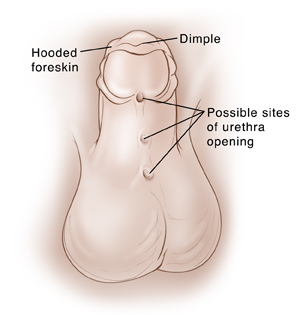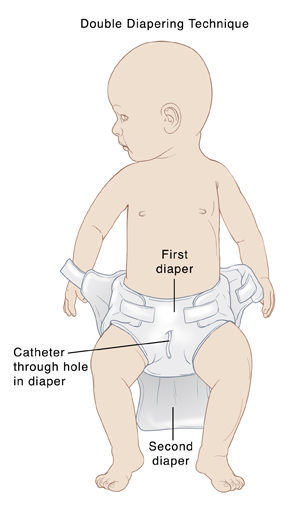When Your Child Needs Surgery for Hypospadias
When Your Child Needs Surgery for Hypospadias
What is hypospadias surgery?
Your child has hypospadias. This means his urethra doesn't reach the tip of the penis. As a result, the opening of the penis (urethral meatus) is located in the wrong place. Surgery can correct this. It can also be done to correct how the penis looks. Your child's surgeon will choose the best method for treating your child. During the procedure, the surgeon will do the following:
Correct the urethra so it reaches to the tip of the penis
Move the urethral meatus to the tip of the penis
Straighten the penis, if needed
Correct how the penis looks
The surgery is usually done by a pediatric urologist. This doctor specializes in the diagnosis and treatment of urinary tract problems in children.
When is the surgery done?
Surgery is typically done when the child is between 3 to 18 months old. More than one surgery may be needed.
The surgical experience
The surgery lasts about 2 to 4 hours. It takes place in an operating room at a surgery center or hospital. Here's what to expect before, during, and after the surgery:
Before surgery. Follow any directions your child is given for taking medicines and for not eating or drinking before surgery.
The day of surgery. You will be able to stay with your child until he is taken into the operating room. You'll then go to a waiting room until he is out of surgery. An anesthesiologist gives your son medicine so he sleeps and does not feel pain during the surgery. Special equipment monitors your child's heart rate, blood pressure, and oxygen levels. Once your child is asleep, the surgeon will start the surgery. The urethra is corrected so it reaches the tip of the penis. This may be done using the foreskin or a small amount of tissue from another area in the body. A tube (called a catheter) will likely be placed into the urethra at the head of the penis. This allows urine to drain freely while the penis heals. The catheter is removed when it's no longer needed.
After surgery. Your child will be taken to a recovery room to recover from the anesthesia. Nurses monitor your child's breathing, blood pressure, and pulse. They also give your child medicine to manage his pain. Your child may be able to go home the day of the surgery. The doctor will tell you when it's OK to take your child home.
Healing after surgery
Your child may have a stitch at the tip of his penis to hold the catheter in place. The catheter will stay in the penis until your child's healthcare provider removes it. Ask your child's healthcare provider how long the catheter will remain in the penis. You will also notice other stitches used to correct the hypospadias. As the penis heals, you will notice swelling, redness, scabbing, and bruising. This is normal. It takes about 3 to 6 months for the penis to heal completely.
Caring for your child at home
To care for your child:
Care for the tube and bandage as you have been instructed. Your child's healthcare provider will tell you whether to change the child's bandage and how to do this. Follow all care instructions for the catheter and dressing carefully.
Manage your child's pain by giving him prescribed medicine. Follow your healthcare provider's instructions carefully. It's best not to wait until pain gets bad to give the medicine. Your child may be in pain if he:
Is irritable
Cries a lot
Refuses to eat or drink
Grabs at the incisions
Give prescribed medicine to your child as instructed. Some medication (antibiotics) may be given to fight infection. Other medication may help keep your child's bladder relaxed while the catheter is in place.
Double diapering
Double diapering is a way to keep the affected area dry and to keep stool off the catheter. It also helps protect your child's penis as it heals. To double diaper:
Cut a hole in the first diaper for the tube to pass through.
Pass the tube through the hole.
Then place a second diaper on your child. This diaper will absorb urine as it drains from the tube.
When to call your child's healthcare provider
Unless advised otherwise by your child's healthcare provider, call the provider right away if:
Your child is of any age and has repeated fevers above 104°F (40°C).
Your child is younger than 2 years of age and a fever of 100.4°F (38°C) continues for more than 1 day.
Your child is 2 years old or older and a fever of 100.4°F (38°C) continues for more than 3 days.
Call your child's healthcare provider if your otherwise healthy child has any of the following:
Your child has a fever of 100.4°F (38°C) or higher
Vomiting
Refusal to drink
Pain not controlled with medicine
Incision that bleeds and doesn't stop
Catheter that isn't draining urine or falls out unexpectedly
No catheter in place and isn't urinating
Updated:
October 16, 2017
Reviewed By:
Greenstein, Marc, DO,Image reviewed by StayWell medical illustration team.

